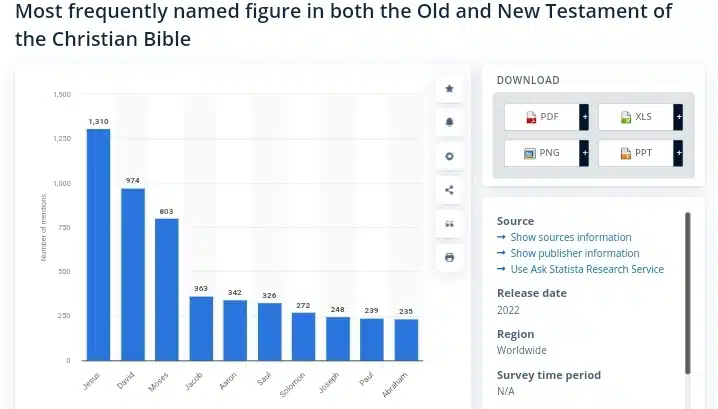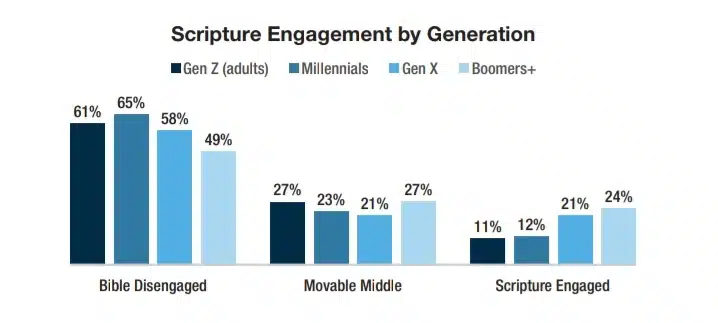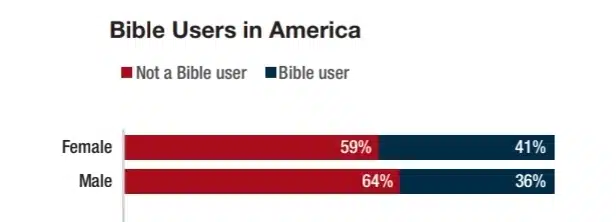
The Bible is a book like no other, with a rich history and a profound impact on human civilization.
But beyond its spiritual significance, the Bible is also a fascinating storehouse of facts and figures.
From the number of words on its pages to the number of languages it has been translated into, these Bible statistics offer a unique glimpse into the scope and influence of this beloved book.
In this article, we’ll see some of the most surprising and intriguing Bible statistics and facts, revealing the remarkable story behind the scriptures that have shaped human history.
Interesting Statistics About the Bible
1. Up to 65 million American adults are open to the message of the Bible. (source)
2. Even though Jesus appears only in the New Testament, His name is the most frequently mentioned in the Christian Bible. It was mentioned 1310 times. Moses, considered the most important patriarch in Judaism, is mentioned 803 times in the Bible. David, the third King of Israel, was mentioned 974 times. (source)

3. According to the book ‘All the Promises of the Bible,’ the Bible has about 7,147 promises of God to man. (source)
4. Approximately 25% of respondents said the Bible had too much influence on American culture, while 41% said it had too little influence. (source)
5. A majority (53%) of American adults wish they read the Bible more, and even among those who rarely or never interact with the Bible, over a third express a desire to do so. (source)
6. Two-thirds (66%) of French practising Catholics said they owned a Bible, up two points from 1988. (source)
7. Gen Z adults show a significant increase in Bible usage, with 21% reporting increased use, compared to only 9% reporting a decrease. In contrast, Millennials are the only age group with a higher percentage of decreased usage (12%) than increased usage (11%). (source)
8. In a survey, 8% of U.S. respondents found the language in the Bible difficult to relate to, and 6% said they didn’t feel excited to use it. (source)
9. Black Americans have the highest percentage of Scripture engagement, with 28% actively engaging with the Bible, surpassing all other ethnic groups. (source)
10. Most surveyed US adults said their favourite testament was the New Testament, but 18% said they were unfamiliar with the Bible. (source)
11. Boomers (24%) are most Scripture Engaged, while Millennials (65%) are most Bible Disengaged. Gen Z adults (18-27) have the lowest engagement (11%). (source)

12. Methuselah, who lived to the age of 969, is regarded as the oldest man in history. (source)
13. 44% of Americans believe the country would be worse off without the Bible, while only 14% think it would be worse off. (source)
14. 50% of Americans believe reading the Bible is important for a child’s character development, an increase from 46% in the previous year. (source)
15. 27% of Millennials and 26% of Gen X respondents say they prefer to read the Bible on a smartphone or tablet app, compared to 9% and 2% of Boomers and Elders, respectively. (source)
16. 58% of people say the Bible’s message has transformed their lives, slightly increasing from 57% last year, with a notable 4% rise to 54% among Gen Z adults. (source)
17. 71% of Americans want to learn more about the Bible and/or Jesus. This shows a significant level of curiosity and openness to exploring spiritual topics. (source)
18. More than half of people in the U.K. believed that the Christmas story depicted in the Bible was more historically inaccurate. Also, less than a third believed it was entirely or somewhat historically accurate. (source)
19. The Bible is translated into 3283 languages in 167 countries. (source)
20. There are about 5 –7 billion printed copies of the Bible worldwide. (source)
21. According to Rev. Peterson’s literary agency, the various “Message” translations have sold over 20 million copies in the past 25 years. (source)
22. Over 100 million copies of the Bible are sold annually, making it the best-selling book in the world to date. (source)
Statistics About Reading the Bible
23. 11% of Americans read the Bible daily. (source)
24. Statistics show millennials were the least likely to read the Bible, while those over 70 were the most frequent readers. (source)
25. 81% of online church attendees (including those who attend both online and in-person) read the Bible independently, compared to 67% of those who attend church primarily in-person. (source)
26. Regarding older readers’ preferences, traditional books were favoured, with 91% preferring to read a print version of the Bible over other formats. (source)
27. Americans still genuinely desire to read the Bible, with 56% of those surveyed in 2019 expressing such a desire. (source)
28. 22% of Americans who read the Bible at least once a month strongly agreed that they were more willing to engage in their faith. Also, 13% said reading the Bible made them more generous with their time, energy, or financial resources. (source)
29. 159 million Americans who read the Bible agree that it strongly influences how they interact with people. (source)
On the other hand, 146 million Americans who read the Bible agree that it has strongly influenced how they treat people of different races. And 130 million agree reading the Bible has strongly influenced their support for refugees and war victims.
30. 27 million Americans say they follow a schedule, study plan, or program when interacting with the Bible. (source)
31. 31% of U.S. practising Christians read the Bible by selecting passages depending on their mood. 35% of non-practicing Christians admitted to doing the same. (source)
Here’s how different people interact with the Bible:
| Non-Christians* | Non-Practicing Christians | Practicing Christians | |
| I select Bible passages depending on my mood at the time. | 27% | 35% | 31% |
| I read a few verses at a time. | 47% | 51% | 50% |
| I use a study guide or commentary to supplement my interactions. | 23% | 23% | 40% |
| I read the Bible at about the same time of the day. | 13% | 14% | 35% |
| I follow a schedule, plan, or program when reading the Bible. | 17% | 14% | 39% |
| I read one or more chapters or a complete story. | 26% | 25% | 40% |
*Non-Christians are those who are of other faiths (such as Judaism) that honour the Bible but don’t consider themselves Christians.
32. In 2022, only 39% of Americans read the Bible. However, nearly one-quarter (24%) of American adults, equivalent to 63 million people, engage with the Bible personally at least once a week outside of church services. (source)
33. Women (41%) are more likely to be Bible Users than men (36%). (source)

34. Among American adults, never-married individuals (30%) are the least likely to use the Bible, while those who are separated (52%) are the most likely to do so. (source)
35. Black Americans (57%) are most likely to use the Bible, followed by Whites (35%) and Asians (27%). (source)
36. Bible use increases with age, with Elders (48%) being the most likely and Gen Z (30%) the least likely. (source)
37. Evangelical (70%) and Historically Black (68%) Protestants have the highest Bible use, while Catholics (37%) have lower engagement. (source)
38. 47% of Bible readers in the U.S. say their biggest motivation for reading the Bible is that “it brings them closer to God.” (source)
20% say they seek wisdom when making life decisions. On the other hand, 15% said they read the Bible because they need comfort. However, only 2% read the Bible because it was a responsibility to do so at Bible study or school.
King James Bible Statistics and Facts
Here are some important statistics and facts about the King James Bible.
39. The King James Bible contains 2 testaments, 66 books, 783,137 words, and 3,116,480 letters.
40. The Old Testament has 39 books, while the New Testament has 27 books.
41. The Bible contains 8,674 unique Hebrew words, 5,624 unique Greek words, and 12,143 unique English words.
42. The Bible has a total of 1,189 chapters and 31,102 verses.
43. The Old Testament has 929 chapters and 23,145 verses, while the New Testament has 260 chapters and 7,957 verses.
44. Cardinal Hugo de S. Caro added chapters to the Bible in 1238, and Robertus Stephanus added verse divisions in 1551.
45. The longest book in the Bible is Psalms, with 150 chapters, while the longest is Psalm 119, with 176 verses.
46. The longest verse is Esther 8:9, with 78 words, and the shortest verse is John 11:35, with only 2 words: “Jesus wept”.
47. The shortest book by the number of words is 3 John and the shortest chapter by the number of words is Psalms 117.
48. The Bible was written over 1,500 years, across 40 generations, by 40 authors from different walks of life, in different places and times, on three continents, and in three languages.
49. The Old Testament contains 17 Historical Books, 5 Poetical Books, and 17 Prophetic Books.
50. The New Testament contains 4 Gospels, 21 Epistles, and the book of Revelation.
Conclusion
As we’ve seen, Bible statistics offer interesting insights into this sacred text’s history, impact, and significance.
From its impressive sales figures to its remarkable linguistic diversity, the facts and figures surrounding the Bible are a testament to its enduring power and influence.
Whether you’re a scholar, a spiritual seeker, or a curious reader, these Bible facts and statistics offer a fascinating window into the world’s most beloved book.
So the next time you open the Bible, remember the incredible story behind its words – and the remarkable impact it continues to have on our world today.

Related Posts:
- Thought-Provoking Gender Inequality Statistics: 160+ Insights Across Regions
- 110+ Shocking Income Inequality Data You Need to Know
- 50 Interesting Sharing Economy Statistics You Need to Know
- 100+ Animation Statistics: The Ultimate Guide To The Industry’s Trends and Insights
- 80+ Franchise Statistics and Facts You Should Know In 2024
- The Future of Learning: 50+ Top EdTech Statistics For 2024
- The Web3 Statistics Report 2024: Trends, Insights, and Predictions
- Meme Statistics 2024: Facts, Trends, and Figures That Will Blow Your Mind
- 85+ MOST Interesting Anime Statistics and Facts (NEW Report)
- Board Game Statistics: Revenue, Market Size, Demographics & More
- 125+ Interesting Airbnb Statistics by Country (Deep Insights)
- 50+ Interesting Born Into Poverty Stay In Poverty Statistics
- 90+ Interesting Film Industry Statistics (NEW Report)
- 80+ Alarming Technology Addiction Statistics You Must Know
- 65+ Impressive Chess Statistics and Facts To Know in 2024
- Spotify Statistics: Latest Report on The Music Streaming Platform
- 50+ Useful Video Game Addiction Statistics, Facts & Huge Trends
- 50+ Vital Internet Safety Statistics & Facts You Must Know
- Internet Dangers Statistics: A Look At The Internet’s Dark Side
- 95+ Interesting Dream Statistics and Facts You Can’t Miss
- 75+ Interesting Relationship Statistics & Facts You Should Know
- Dance Statistics: A Deep Dive Into The Rhythm Of Movement
- 40+ Incredible Single Father Statistics You Have to Know
- The Battle of the Sexes: Male Vs. Female Spending Statistics
- 95+ Jaw-Dropping Period Poverty Statistics You Need To Know
- 70 Exciting Love Statistics And Facts (True Love, Intimacy, Marriage, Dating & Relationships)
- 30+ Gentle Parenting Statistics & Facts: Is This Parenting Style Worth It?
- 55+ Useful Black Consumer Spending Statistics (2024 Report)
- Holiday Spending Statistics: Valentine’s Day, Easter, Thanksgiving, & Christmas

